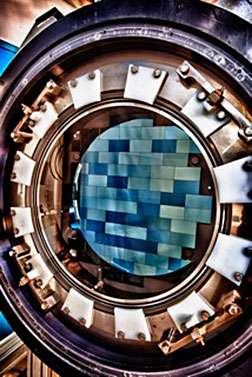Dark Energy Camera unveils small objects in solar system

The 570-megapixel Dark Energy Camera, built at DOE's Fermilab and mounted on the 4-meter Victor Blanco Telescope in Chile, delivers some of the most detailed images of celestial objects. While about a third of the camera's observing time goes to scientists working on the Dark Energy Survey, dozens of other teams share the remaining time. While the majority of them focus on observing objects far away, five groups recently highlighted in Symmetry magazine are investigating things close to Earth, looking for "space junk" that could damage satellites, large rocks that could hit Earth and other objects traversing our solar system.
Stony Brook University's Aren Heinze and the University of Western Ontario's Stanimir Metchev use DECam images to look for undiscovered members of our solar system's main asteroid belt, which sits between Mars and Jupiter. They stack more than 100 images taken in less than two minutes to detect the positions, motions and brightnesses of asteroids not seen before.
Scott Sheppard of the Carnegie Institution for Science in Washington DC and Chad Trujillo of Gemini Observatory in Hilo, Hawaii, use DECam to look for objects in the Kuiper Belt. On their first observing run, they found an object now named 2012 VP113. Along with Sedna, a minor planet discovered a decade ago, it is one of just two objects found in what was once considered a complete no-man's land. The team also has discovered another dwarf planet, a new comet, and an asteroid that occasionally sprouts an unexpected tail of dust.
Northern Arizona University's David Trilling and colleagues use DECam images to look for "centaurs"—so called because they have characteristics of both asteroids and comets. Astronomers believe centaurs could be lost Kuiper Belt objects that now lie between Jupiter and Neptune. Because centaurs are nearer to the sun than Kuiper Belt objects, they are brighter and thus easier to observe. Trilling's team expects to find about 50 centaurs in a wide range of sizes, which will reveal information on the size distribution of Kuiper Belt objects.
Lori Allen of the National Optical Astronomy Observatory and her colleagues are looking for near-Earth objects with orbits that can cross Earth's—creating the potential for collision. Allen's team specializes in some of the least-studied near-Earth objects: ones smaller than 50 meters across. They expect to discover about 100 objects the size of the one that exploded above Chelyabinsk, Russia, in 2013 and injured more than 1,000 people.
Patrick Seitzer of the University of Michigan and colleagues are using the DECam to look for "space junk"—inactive satellites, parts of spacecraft and the like in orbit around the Earth. Most surveys can identify only pieces larger than about 20 centimeters. But there's a lot more material out there. Seitzer's team hunts for debris smaller than 10 centimeters, or the size of a smartphone. With as few as four images of a piece of debris, they can determine its position, motion, brightness and risk to satellites in geosynchronous orbit. Their results are scheduled for release in mid-2015.
Provided by Oak Ridge National Laboratory





















